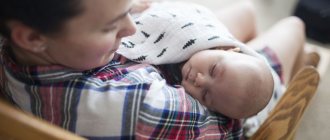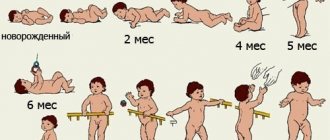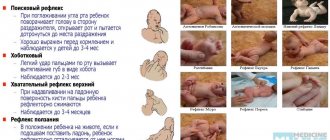Just recently the baby was just born, but has already acquired many skills. A 2-month-old baby already shows interest in his surroundings, but is completely dependent on his mother. To understand how the baby’s developmental rhythm corresponds to the norms, parents need to know the accepted parameters of weight, height, skills and abilities. For complete care, you should find out your daily routine, sleep patterns and nutrition.
Physical indicators
A 2-month-old baby no longer looks as small as in the first month of life. The baby resembles a round-cheeked and cheerful toddler. During this time, he gains about 800-1000 grams in weight and stretches another 2-3 cm.
If in the first days the skull circumference grows rapidly, then the head of a 2-month-old baby no longer gains volume so quickly. By the end of the second month, it should have parameters of about 38-40 cm. At the same time, the size of the fontanels is reduced. And the small one, located behind the skull, may already close. In any case, this should happen no later than three months of life.
The baby's height also increases. Optimal indicators depend on the sex of the newborn. If girls can have a body length of 57 cm, then boys are already 58 cm. The weight of the children also differs. Boys are always heavier, their weight should be within 5.6 kg, and girls’ weight should be 5.1 kg. But these are averages. When setting the norm for each specific baby, the doctor focuses on the weight that was at birth and its gain weekly.
Educational activities and games for a two-month-old baby
Now the baby's waking time has increased - he is ready to lead an active lifestyle for 1.5 - 2 hours in a row, and the mother can take advantage of this by engaging him with games. Of course, games and activities should be short - up to 25 minutes.
The baby will be happy to watch you finger his fingers, telling a fairy tale about the “white-sided magpie” who “cooked porridge and fed the children.” This is also very useful for developing speech skills.
You can already talk to the child. You tell him “ahu, ahu,” he listens, looks at your moving lips and responds with something like “egh” or “argh.” You “ahu” again, he again “egh”... Here is the dialogue!
The child becomes more and more purposefully interested in sounds. Whether the bell rattles or the phone rings, he concentrates and searches not only with his eyes, but also with a turn of his head: “Where is this from? What is this?"
The child gets great pleasure from the opportunity to swing his arms and legs and hit the hanging toys with them. It is best to take toys that, after hitting them, begin to ring or swing and rotate. Arrange the baby so that he can reach them first with his hands and then with his feet. Attaching a plastic circle with a face on it to the pendant will make the game even more fun.
Before entering your baby's room, call him. He will learn to recognize your voice and will wait for you to appear.
Dear mothers and fathers, exactly one month has passed since the birth of your child. During this time, you have learned to understand the baby’s language well and predict his desires. The first fears and doubts, and perhaps the first mistakes, are left behind. You have accumulated invaluable parenting experience, and now, together with your baby, you are ready to master a completely new daily routine for a 2-month-old baby.
From this article you will learn:
Worth paying attention
A 2-month-old baby should be weighed at the same time every day. Recommended time: in the morning, before feeding. It is known that evening indicators may differ from morning ones to a greater extent, but it is not recommended to compare them.
It is important that the baby looks healthy, cheerful and round-cheeked. His physique is plump. However, the child’s activity increases every day, so by the end of the period under review, the arms and legs noticeably stretch out, and the body also lengthens. Due to active life, the baby’s muscles are strengthened, and the congenital fat layer is reduced. By the end of the second month, the baby will become taller and noticeably slimmer.
How do you know if the formula is right for your baby?
The adapted formula is suitable for a child if he eats it with pleasure, gains weight in accordance with the recommended norms, his skin is clean (without rashes, dryness and roughness), his stool is mushy or “sausage” yellow in color without foreign impurities.
We suggest you read: How many times can you perform a medical termination of pregnancy?
The formula is not suitable if the child has:
- the tummy is constantly bloated;
- loose stools, foamy, with greens and mucus;
- dry skin or rashes on it are determined.
Closer to two months, due to an increase in the volume of formula consumed, children may show signs of lactase deficiency, which requires nutritional correction.
Features of a two month old baby
Any 2-month-old child has its own developmental characteristics, but there are basic ones that are observed in almost all babies:
- During this period, hair change begins. The vellus or baby hairs fall out, and the usual bulbous hairs grow in their place.
- The baby expresses his attitude towards smells at the level of reflexes. If the aroma is pleasant, then the child may smile or freeze, otherwise he sneezes or even cries.
- A 2 month old baby is more sensitive to pain. At the same time, he reacts sharply to any discomfort. A crying baby notifies you of a wet diaper, abdominal cramps, cold, or lack of attention from adults.
- Vision improves. The baby already perceives his pacifier, toy or bottle. While awake, his gaze catches objects located near him. He reacts to his mother’s face with a smile and animation. In this case, concentration on objects can reach five minutes.
- If during birth the baby experienced certain difficulties, then he could develop vascular spots in the forehead and back of the head. In a 2-month-old baby, they gradually become pale and may disappear completely.
Parents should understand that if the vascular spots do not fade, then it is necessary to bring the problem to the attention of a doctor. Such a pathology may indicate disturbances in cerebral circulation.
Baby's health at 2 months
In the third month of life, many children, especially those born in the cold seasons of the year, may experience initial signs of vitamin D deficiency rickets (including children who receive a prophylactic dose of vitamin D). Parents can pay attention to the baby’s increased excitability, sweating, increased urination, and baldness of the back of the head. In this case, a doctor’s consultation is necessary: you may have to increase the dose of vitamin D, change the drug, or change the child’s diet.
After 2 months, some children who did not previously have obvious signs of disorders of the nervous system, but suffered hypoxia (oxygen starvation) in the prenatal period or at birth, may experience neurological disorders: increased excitability, tearfulness, trembling of the hands and chin when screaming, changes in muscle tone - the child resists when trying to spread his legs or arms; when supported under the armpits, he does not rely on the entire foot, but only on the toes. If parents notice such features in their baby, it is necessary to contact a pediatric neurologist. In the third month of life - if the child has not been examined by these doctors earlier - all children also need to consult an orthopedist and an ophthalmologist.
Of course, increased excitability is not always a manifestation of perinatal damage to the nervous system. Often the reason is that in the third month of the child’s life, parents already get used to him, begin to treat the baby more calmly, can disrupt his routine, invite guests, and remember the existence of television. Noisy conversations and loud music significantly excite the child’s immature nervous system and exhaust it. In the room where the child lives, it is advisable to stop watching TV and give preference to melodic, quiet music.
If the child has so far grown up mainly in diapers, now it’s time to change his clothes - he needs rompers when he’s awake. When the room temperature in winter is 21-22°C, there is no need to wear woolen socks over the rompers, although they can be used while walking. Wrapping up your baby causes him to sweat and catch cold easily in drafts. At the room temperature indicated above, you can wear short pants, socks or knee socks while the child is awake. Let him stay with bare knees for 10-15 minutes first, and then for the entire waking period.
Motor skills
By the age of two months, the innate muscle tone should gradually subside. At the same time, spontaneous movements increase. It is important that when lying on its side, the baby no longer throws its head back strongly, as in the period after birth.
To assess the level of development of a baby at two months, you can take the following indicators as a basis:
- knows how to bring his hands and objects in them to his mouth;
- touch toys hanging near him, push them away from him;
- hold a rattle or other convenient object placed in your hand (at least 10 seconds);
- rubs his nose with his fist when there are strong odors, and if he wants to sleep, he can rub his eyes;
- tries to raise his head and holds it for several seconds;
- pays attention to the voices of loved ones.
A two-month-old baby is already actively showing interest in his surroundings. If you hang rattles over the crib, the baby will definitely try to grab and feel them. In the second month of life, the baby is interested in everything. He may crumple up daddy's book, grab mommy's hair, crumple diapers, or try to get a toy located nearby.
How much should a 2 month old baby sleep?
Most often, a child’s routine at 2 months is already quite established: the baby sleeps and feeds at regular intervals. There is a gradual decrease in the amount of time allocated to sleep. At two months, the baby usually sleeps 16-18 hours a day. The periods of daytime sleep are becoming a little shorter - now the child sleeps for one and a half to two hours 3-4 times a day. And sleep at night can be up to 9 hours.
The child has confused day and night: what to do?
The question of how to establish a child’s daily routine at 2 months is especially of concern to those parents whose child has “confused” night and day: the child is awake at night and sleeps during the day. This is very problematic for parents, because it becomes difficult for them to maintain a normal daily routine. Therefore, you need to try to change the baby’s routine. Don't let him sleep more than 4-5 hours during the day, try to entertain him longer. And before going to bed at night, bathe him daily and sing lullabies to him so that the child relaxes as much as possible. Then your sleep will be stronger.
If bathing is an evening ritual for you, then massage and light exercises can be a morning ritual. Stroke the baby's arms, legs, back, then massage the tummy. Young children really like this and increase their activity in the morning.
Big achievements for a little man
A healthy 2.5-month-old baby is growing stronger day by day and is rapidly gaining weight. He quickly learns to adapt to new conditions. So, if the baby is placed on his stomach, he holds his head quite confidently. It is necessary to place rattles in the hands to develop the grasping reflex. At this age, the child is already able to hold an object in his hand for some time.
If you hold a bright and large object in front of the child’s eyes, the baby is able to follow it with his gaze. He is also interested in where the sound is coming from and turns his head towards its source.
The main achievements are the following:
- if in the first month the child’s arms were tightly clenched into fists, now he straightens them more and more often;
- the eyes distinguish not only the object itself, but also the main details;
- reacts when there is a sound and turns its head;
- able to attract the mother’s attention not only by crying, but also by facial expressions;
- may become very frightened if there is a loud sound;
- the first buzz appears;
- back-lingual sounds (g-g-g or k-k-k) may be heard;
- a smile appears towards loved ones;
- lying on his stomach, he often raises his head, drops it and tries to raise it again.
What can a 2 month old baby do?
From birth, the child’s nervous system continues to develop and improve. Innate reflexes fade away. The child constantly trains his movements, develops coordination, and acquires conditioned reflexes. Acquired reflexes can cause a child to fall, even if he is not actively moving. Therefore, do not leave him alone in dangerous places where he might fall. The baby's actions are more purposeful than before. The baby takes great pleasure in learning his movements. Having spent most of its life in the mother's belly in a bent position, the child often keeps his arms and legs bent and his fists clenched. Periodically, he unclenches his hands and straightens his legs and arms, stretching out. By the end of the second month, the tone of the hands and fingers should go away. That is, the brush should be relaxed and open. The neck muscles develop; to help them, place your baby on his tummy more often. By the end of the second month, the baby can hold his heavy head for 15 seconds.
By the end of the second month of life, the child begins to follow moving objects in his field of vision. For example, he is interested in a mobile hanging above the crib. He can see further than before (objects more than 50 cm away). The child looks at his mother's face with interest. Due to the fact that the facial muscles are not yet sufficiently developed, the baby may cross his eyes. Don't be alarmed, this will most likely go away with time. The baby does not distinguish colors except black and white. Therefore, most often he turns his attention to contrasting objects, preferring light colors. The child knows his mother's face. Can focus on an object for a short time.
At about 2.5 months, the baby begins to try to grab bright toys that are interesting to him. He happily pushes, touches, feels, everything that surrounds him. He is no longer interested in lying around doing nothing.
This age is characterized by the so-called “revival” complex, when the baby reacts vividly to the appearance of people he knows and loves - he smiles, begins to walk, and actively wags his arms and legs.
Time to sleep
It is important to know how much a 2-month-old baby sleeps in order to adjust his lifestyle. At this age, doctors recommend at least 3-4 naps per day. Of course, each parent sets the daily routine in his own way, and is based on the time of morning awakening and personal convenience. But there are some points to consider:
- after waking up in the morning, the baby is fed, followed by a period of active wakefulness, which lasts about 1-1.5 hours;
- This is followed by the first daytime nap, which lasts about 2 hours;
- During the day, feeding, wakefulness and sleep alternate;
- walks are recommended during any of the dreams;
- before going to bed at night, water procedures are necessary;
- It is better to go to bed at night no later than 21-23 hours.
Usually a 2-month-old baby sleeps soundly if nothing bothers him. But before three months, the intestinal flora is formed, so the baby often experiences discomfort in the tummy. To alleviate the condition, it is recommended to use special medications against flatulence and bloating.
Features of the daily routine at 3 months
The routine described earlier in the table for a two-month-old baby is approximate. Parents must remember that each child is individual in his development. So, for example, if some children need time to stay awake after bathing, then for others, mandatory feeding is necessary, and only after that they are ready to fall asleep.
There is a category of children who confuse day and night, wake up very early, not at 6.00, as their parents would like, but at 4.00-5.00. Such an irregular sleep-wake schedule has a negative impact on other family members, who often have to adapt to this daily routine.
In order to accustom the baby to a routine at 2 months, the adults themselves must adhere to it. Walk, bathe, do gymnastics, feed breast milk or formula, at a strictly defined time. As a result, such an organization of the daily routine can bring its “positive results.”
Tips for a good night's sleep
If a 2-month-old baby does not sleep and constantly cries, the cause is most often the accumulation of gases in the intestines. At this age, the functioning of the digestive system has not yet been established, there are not enough enzymes, so flatulence is a common companion for children under three months.
The pediatrician should advise how to treat a 2-month-old baby for bloating. Basically, doctors prescribe Espumisan, Bobotik, Plantex, Babyform Baby and others. You can use dill water. It is also useful to follow a few tips:
- After feeding, you should not immediately put the baby to bed. It is necessary to hold it in an upright position so that the air that the child has swallowed can escape.
- It is better to lie on your side to sleep. This way you can avoid not only choking during regurgitation, but also deformation of the skull in the back of the head. Only the position of the body needs to be changed regularly.
- To ensure that the baby is not bothered by colic and sleeps soundly, the mother herself must follow a diet and not eat foods that contribute to severe gas formation.
Feeding, sleep and wakefulness are the main guidelines for a baby’s daily routine.
The daily routine of an infant excludes strict adherence to hourly intervals, but requires adherence to a sequence of actions, events and procedures. With a young child it is impossible to comply with all time restrictions due to his undeveloped adaptation to the outside world and immature physiological systems. If colic or bloating brings significant discomfort to the baby, it will be difficult to put him to bed at the set time, the mother will need help to alleviate the pain.
All the life activity of the small inhabitant of the house is based on his three basic needs, around which the entire regime will be built: feeding, sleeping, waking.
Sleep will gradually decrease, and the baby will begin to spend more and more time awake and communicating with parents. When creating a feeding regimen, you should focus on the type of feeding: breast, artificial or mixed. Natural breastfeeding remains a priority.
The mother's breast is an intermediary in strengthening the special maternal bond with the child, and breast milk is a natural source of balanced nutrients and antibodies to protect the weak child's body from the influence of pathogenic microorganisms.
Basics of proper care
In order for the baby to grow and develop at the right pace, he needs proper care, walks in the fresh air and feasible activities. Parents should consider the following points:
- You should try to walk every day, at least 3-4 hours. Of course, weather conditions are taken into account.
- Constantly place the baby on his tummy. This position helps strengthen the neck muscles and the proper development of the spine.
- Air baths are very useful. If the house is warm, then you can leave the child naked for the entire waking time. During the cold season, it is important to expose the baby during diaper changes and before water procedures.
- It is necessary to massage every day. For this purpose, light stroking, kneading the limbs, and patting the feet are used. You can put your fingers in your baby's arms and, as soon as he grabs them, carefully lift them up. But this exercise should be done on a soft surface.
- To develop fine motor skills, it is useful to use objects of different textures and weights that are given to the baby’s hands.
Daily schedule for a two-month-old baby (BW):
6.00 Morning feeding, washing, changing a diaper and cutting nails 2 times a week;
7.30-9.30 Sleep after feeding;
9.30-11.00 Wake up the baby, put him on his stomach after sleep. Feeding. Getting ready for a walk in the fresh air;
11.00-13.00 Sleep while walking in the fresh air;
13.00-14.30 Feeding;
14.30-16.30 Daytime nap;
16.30-17.30 Breastfeeding. Activities with the baby aimed at his development: stopping the gaze on an object, rhythmic clapping along with rhymes and songs.
17.30-19.00 Sleep;
19.30-21.00 Feeding, evening bathing and hygiene procedures;
21.00-23.30 Sleep;
23:30-00:00 Feeding;
00.00-6.00 Sleep. Pediatricians recommend choosing this particular time period for night sleep. If the baby wakes up at night and demands the breast, then you should not refuse him this.
The proposed daily routine can be adjusted based on the characteristics and character of the baby. Children who are sick should sleep longer. If the child begins to be capricious and whine, then do not overtire the baby and put him to bed. There is no need to starve your child if he wants to eat before the allotted time.
Keep in mind that we are talking about a 15-20 minute discrepancy here. Some young mothers are unable to adhere to a daily routine, as they begin to indulge their baby’s every whim. Because of this, the schedule gets lost and is difficult to restore.
If you notice that your child is gradually deviating from the norm, then make every effort to ensure that the daily routine is restored. After all, the daily routine can be disrupted not only for the baby, but also for the parents and other family members.
What can a 2 month old baby eat?
At this age, the ideal food for a baby is breast milk. But the regime may already change. If before this time the child ate almost constantly and breasts were offered on demand, now a certain pattern can be observed. The intervals between meals range from 2 to 3.5 hours.
If the baby is bottle-fed, then only adapted milk formulas should be used. Of course, such nutrition requires compliance with strict standards. Usually the manufacturer gives his recommendations on the packaging; you can also consult your doctor. But there is a formula that shows the required amount of milk needed at this age. In the period from 2 to 3 months, it makes up 1/6 of the baby’s body weight. The result obtained must be divided by the number of daily feedings, of which there are six in total. This way you can calculate the approximate amount of food needed per serving.
Parents often wonder whether it is possible to give a 2-month-old baby complementary foods. Pediatricians clearly state that at this age only mother's milk or formula is necessary. All other food is prohibited. The exception is clean drinking water. If the baby is artificial, or it is too hot outside, then you need to offer him warm water.
What to feed a two-month-old bottle-fed baby?
Several decades ago, complementary feeding at 2 months with breastfeeding or bottle feeding was considered the norm.
Now, having heard from the pediatrician that it is time for a child at this age to be given porridge or a few drops of juice, the mother needs to think about how qualified this doctor is.
If the neighboring women talk about how great their kids are and how they like to eat an apple and yolk, this does not mean that you should immediately follow their example. We will tell you why you should not give your baby juice and puree at such a tender age.
The second month of a child’s life is not the time to introduce your daughter or son to solid foods. Why is modern medicine so categorical, what myths exist among parents, and why is it so important for nursing mothers to eat right? You will find answers to these and other questions in the article.
Often on forums of caring mothers you can come across the question: “What can you feed a baby at 2-3 months?” Women willingly share their recommendations. If a dispute arises, they defend their point of view by the fact that if you start giving solid food earlier than the time recommended by doctors, the stomach will not react as strongly to food innovations than at 5-6 months.
Pediatricians and gastroenterologists have a completely different opinion on this matter.
During breastfeeding, immunoglobulins and albumin from breast milk are absorbed into the baby's body. If you start giving him complementary foods at such an early age, then foreign proteins will partially enter the intestines, which can cause an allergic reaction.
In some cases (for example, when a child is introduced to cow's milk), the toddler may become intolerant to milk protein, and sometimes lactose.
Another myth that mothers defend is that “we were fed from 1-2 months, and everyone grew up healthy, no one died.” First of all, it must be said that diseases of the gastrointestinal tract are widespread everywhere. And doctors and scientists believe that this is precisely due to the inappropriate introduction of early complementary feeding.
In addition, the issue of child mortality needs to be addressed. This especially applies to children of village “non-dairy” mothers.
Already from 2-3 months of age, the yolk, the crumb of freshly baked bread with soup, was introduced into their diet. Official statistics of those times say that up to 40% of babies died on such a diet.
The strongest survived, those who did not die from numerous diseases, severe frosts, intoxication, and, among other things, early complementary feeding.
The introduction of solid foods into a breastfed or formula-fed baby's diet should be discussed with your local pediatrician. When the baby is 6 months old, the doctor will tell you which foods to start with. Feeding a baby additional food at such a tender age often causes allergies and problems in the immature gastrointestinal tract.
Surely, you have heard that some 20-30 years ago, children began to be fed juices, yolks and apples in the first months of life. There are several explanations:
- Since breastfeeding was not organized correctly, the lactation period quickly ended. And to make up for the lack of nutrients in the baby’s diet, mothers gave their babies adult food. There was a risk of a decrease in hemoglobin by 3-4 months, which is why doctors recommended introducing complementary foods into the diet of a 2-month-old child.
- At that time there were no such high-quality milk formulas, so there was no other choice. Nowadays, high-quality children's products can be purchased at any store or pharmacy. It contains all the necessary micro- and macroelements, vitamins and prebiotics.
Even if the mother’s milk supply has decreased, lactation can most often be returned. To do this, it is necessary to put the baby to the breast as often as possible and practice night feedings. After all, it is in the dark that the female body intensively produces prolactin, a hormone that is responsible for lactation.
Modern pediatricians are against feeding infants up to 6 months of age. On this issue, they fully support the point of view of their Western colleagues, who found that:
- Until 5-6 months of age, the child’s body is not able to absorb proteins that are not part of breast milk. This is due to the reduced activity of hydrochloric acid and some enzymes. Children digest casein, a protein found in cow's milk, especially poorly. In some cases, eating inappropriate foods can lead to serious metabolic changes.
- The body of a baby up to 5-6 months does not digest carbohydrates well. The activity of amylase, which is responsible for their breakdown, is only 10% of the level in adults. Therefore, there is absolutely no benefit for the baby in the early introduction of complementary foods in the form of cereal or milk-cereal porridges and baby cookies.
- By 6 months, children's ejection reflex fades away. Over time, they learn to push food through the mouth with their tongue and learn to swallow it. The same applies to liquids. Experts believe that the reflex protects the child from suffocation. If a foreign object gets into the baby’s mouth, the tongue immediately protrudes out, pushing out the potential threat. To check whether the baby’s reflex has disappeared, give him some water from a spoon. If he pushed her out, then it’s too early to introduce complementary foods.
- Foreign doctors believe that early introduction of complementary foods leads to excessive obesity. After all, when eating from the breast or bottle, the baby himself is able to regulate the amount of food he needs. Caring parents, feeding the baby from a spoon, forget that the volume of his stomach is equal to his fist. Therefore, they often overfeed their babies, which causes them to have stomach ache and problems with the functioning of their internal organs. In addition, diabetes and celiac disease may develop at an older age.
- In children who are introduced to early complementary feeding, the risk of developing food allergies and eczema increases.
- Doctors believe that foods thicker than mother's milk or high-quality formula in an infant's diet place too much stress on the liver and pancreas. And you may be bewildered and object, but what about mother’s milk, which has a fat content of 4%? The natural product produced by your mammary glands contains certain enzymes that help your baby digest milk. Did you know that it is normal to have no bowel movements for 5-7 days while breastfeeding? This is explained by the fact that mother’s milk is completely absorbed by the child’s body.
- Many pediatricians are inclined to not introduce food into the baby’s diet until his first teeth erupt (that is, until 6-7 months). Keep in mind that the toddler’s readiness for complementary feeding is not related only to the fact that your child has become toothy. If he has his first tooth at 3-4 months, then this is not a reason to cook him porridge and vegetable and fruit purees.
- Early complementary feeding interferes with natural feeding. The baby begins to suckle less, and because of this, the mother's milk production rapidly decreases.
Pediatricians believe that even if the mother was unable to establish lactation and the baby lacks milk, toddlers do not need to make nutritional adjustments until 4-5 months by introducing complementary foods into their diet. They can receive all the necessary nutrients from an adapted milk formula.
Finally, we want to talk about a very important aspect. If you are wondering whether it is possible to give an apple or carrot juice to a baby at such a tender age, because it contains so many vitamins and nutrients, then it is better to eat it yourself.
As a rule, trying to provide the child with the highest quality nutrition and complementary feeding, mothers forget that they themselves need to eat as well as possible.
Include freshly prepared natural juices, vegetable salads with herbs, lean meats and fish, cereals and dried fruits in your diet, and your baby will definitely get the right amount of macro- and microelements from your milk.
Until the age of six months, the baby does not need to be given anything other than breast milk or an adapted milk formula if your baby is bottle-fed. Do not listen to either grandmothers or “experts” who advise feeding your child purees and cereals at such an early age. Trust your intuition and do not trust others unconditionally.
How would you rate this material?
We suggest you read: Night feedings: up to what age should you feed your baby at night, how many times...
You should not think about introducing complementary foods at two months. Most eating disorders at this age are caused by the desire of parents, most often mothers, to force things. Very often, the early introduction of complementary foods is caused by “helpful” advice from neighbors or friends. Focus only on information obtained from reliable sources - in your case, this is a doctor or specialized literature.
The only product that should be given to your baby besides milk is water. And it must be absolutely pure and free of impurities. You should not assume that mineral water is suitable for your baby - the substances it contains can have a negative impact on his health. The best choice is purified table water or special water intended for babies.
There is only one answer - an age-adapted mixture. Manufacturers now indicate the age directly on the packaging of baby food. And, if you picked up the formula earlier, at one month, and the baby tolerates it well, there is no point in changing the diet.
Some pediatricians, in the old-fashioned way, prescribe apple juice drop by drop from two months, supposedly in order to avoid anemia. Should not be doing that. Recent studies show that such early introduction of juices only harms the baby’s digestion, and therefore can aggravate the symptoms of age-related anemia.
Water treatments
How many days a week should a 2 month old baby bathe? If previously babies were bathed daily, now you can do this every other day. However, the genitals are washed as needed. Of course, parents have already acquired a certain skill, and bathing does not seem so exciting. Water procedures are recommended to be carried out in the evening, before bedtime. It is necessary to use a baby bath, to which you can add decoctions of chamomile, calendula, string, lavender or oak bark. The temperature should be about 37 degrees. The temperature in the room should be about 24 degrees.
Sample routine
Children are completely different, and even at the same age they have their own daily routine. The main task for the mother is to carry out the necessary procedures that are included in the schedule.
Approximate daily routine:
- 06:00 - 06:30 - baby wakes up and eats.
- >06:30 – 07:30 – wakefulness. Mom carries out hygiene procedures (washes the baby, changes the diaper, cuts off the nails, cleans the nose), and light exercises.
- >07:30 – 09:30 – the child is resting.
- >09:30 - 11:00 - the baby woke up. The mother feeds the baby breast milk or formula. After eating, it is important to hold the baby in a column to allow excess air to escape.
- >11:00 – 13:00 – sleep, preferably outside.
- >13:00 – 14:30 – child eats, educational activities with mother.
- >14:30 - 16:30 - third sleep.
- >16:30 – 18:00 – wakefulness. Spending time with family members.
- >18:00 – 20:00 – evening rest.
- >20:00 - 21:30 – mother feeds baby, bathes. If the room temperature is not lower than 22°C, leave the baby naked for 5 minutes. Air baths are beneficial for children.
- >21:30 - 23:30 - sleep.
- >23:30 - 00:00 - last meal before night's rest.
- >00:00 – 06:00 – sleep. This period is considered normal for a baby. In fact, a child can wake up 2-3 times in 6 hours to eat. Under no circumstances deny him this.
This is one of the approximate daily routines; each child has his own.
Lactation
The best thing for a 2 month old baby is being united with mom
Breastfeeding is one of the best options for feeding a baby. Mother's milk contains essential vitamins that the baby needs so much and antibodies to viral diseases. Breastfeeding is recommended at the baby's first request; let him eat as much as he wants. Typically, hunger in children occurs every 2-3 hours, which coincides with the normal daily schedule. Most mothers use this method of breastfeeding; it helps meet the baby's needs and reduces the risk of milk stagnation. The child feels the constant closeness of his mother and cries less because he feels comfort and protection.
The daily intake for a 2 month old baby is 900 ml of milk, serving is 130 ml. The duration of one breastfeeding for complete saturation is 20 minutes.
Premature babies can stop breastfeeding within 5 minutes of starting feeding. Thus, they receive only “foremilk”, which is released without effort on the part of the baby. It is more liquid and watery. To ensure complete saturation, it is important for a baby to eat both “front” and “hind” milk. To ensure that the child eats properly, pediatricians recommend partially expressing “light” milk before feeding. If such a situation arises, consult your pediatrician on what to do.
How much does the baby eat? Don't keep your baby at your breast for too long. Some babies, having had enough in 20 minutes, hold the nipple in their mouth for another half hour, sucking it periodically. This is how they replace their pacifier. Moms need to know that this situation will negatively affect the nipples. Cracks may appear on them, which will further cause discomfort when feeding.
Another sign that your baby is getting full is the number of diapers used. Normally, a 2-month-old baby pees up to 15 times a day and poops 2 to 4 times.
Artificial feeding
Newborns who are fed only formula are fed strictly on a schedule. Although dry formulas are a complete substitute for mother's milk, the composition and beneficial properties are different. They are much heavier for the baby’s stomach and require more time to be completely digested.
To feed a 2-month-old baby, formula No. 1 is used 5-6 times a day. The volume of one serving is 100-120 ml. The recommendations in the instructions should be followed correctly.
Formula-fed babies should be given drinking water between meals. It is worth feeding artificial animals while holding them in your arms. This way they get close contact with their mother, which they so desperately need.
After each feeding, whether artificial or breastfeeding, the baby is held in a “column” so that the air trapped in the stomach is released. In case of excessive regurgitation, you should consult a doctor, because this may be the first signal of a problem with the baby’s gastrointestinal tract.
Dream
A 2-month-old baby sleeps a lot, the main thing is that the sleep is also sound
As already mentioned, a 2-month-old baby needs to sleep up to 16 hours a day. Then he will be cheerful, able to explore the world, and eat with appetite. The baby should fall asleep on its own, without rocking. This is achieved if the mother accustoms the baby to the regime from birth. Then the child will know when it is time to rest and fall asleep without mother’s help.
Babies 2 months old often have problems sleeping. This is due to the need for the physical presence of the mother. If she is nearby, the baby will sleep for a long time and without interruptions. Otherwise, the baby’s sleep will be short and end in crying.
Often babies combine sleep and nutrition, falling asleep near the chest. In this case, the child’s eyes are closed and the body is relaxed. You shouldn’t leave the little one alone; it’s better for mom to lie down next to her and take a 30-minute break from household chores.
It is recommended to bathe your baby before bedtime. This event is held between 20:00 and 21:30 with a duration of up to 5 minutes. Bath procedures will relax, relieve stress and calm the child. Then the baby will fall asleep faster and sleep longer. It is important that the water is not too hot or cold; the recommended temperature is 37 - 39°C.
Reasons why your baby may not sleep well:
- Inactive behavior while awake.
- A feeling of discomfort, such as a rumpled sheet, a heavy blanket, or a full diaper.
- The room is hot or cold (the temperature should be between 20 - 22°C). It is recommended to ventilate the room 2 times a day.
- Extraneous noises, such as the TV playing, the phone ringing, parents talking loudly.
- Bright light in the room.
- Abdominal pain, colic.
Children who are used to falling asleep from rocking in their arms find it harder to fall asleep on their own. Here mothers create their own method. You can spend the time before bedtime more actively so that the baby is tired, reduce the noise and dim the lights in the children's room, sing a lullaby, or just talk calmly and affectionately with the baby.
To accustom the baby to a routine, the mother should follow it herself. Get up at 06:00 and wake up the baby, wash, feed and put him to bed after an hour and a half. Continue as scheduled. After 2-3 weeks the baby will follow his mother’s rules.
Water procedures and gymnastics
Daily water procedures at 2 months are carried out in clean water
It is worth adhering to a daily routine both regarding nutrition and sleep, and bathing. Mom carries out water procedures at the same time. You need to wash your baby taking into account the following rules:
- Soap, bubble bath or shampoo should only be used once a week.
- Daily bathing in ordinary clean water.
- Adding a decoction of chamomile or string is allowed if the baby has heat rash.
- The temperature of the water in the bath is 37 - 39°C.
- It is not necessary to bathe only in the evening. It is important that this procedure takes place every day at the same time.
- The duration of the procedure is 5 - 8 minutes.
Usually after bathing the baby feels tired, eats and goes to bed.
Mothers should not forget about daily exercise for their child. It is done in the morning after the first or second sleep. You should not exercise directly after eating.
Morning exercises begin with lightly stroking the baby. Then they do flexion and extension of the legs, spreading the arms to the sides or up/down, and the “bicycle” exercise. If your baby suffers from colic, give him a tummy massage. Place the baby on his back and gently move your hand clockwise around the navel. Bend the baby's legs towards the tummy, applying light pressure.
Entertainment
Walking in the fresh air is extremely important for a two-month-old baby. In the warm season, their duration should be at least 2 hours. In summer, it is better to go outside before 11:00 and after 16:00, then the sun is not too hot, and the air is not so hot. Avoid exposing your baby to direct sunlight.
Don't get carried away with walks in winter. If the air temperature is below -10°C, it is better to stay at home. If the child does not sleep during a walk, take him in your arms and show him the world around him. Try to walk in parks or courtyards, away from noisy roads.
To keep your little one busy, you can play with him. For a 2-month-old baby, it is worth choosing games that will stimulate the development of vision and hearing, physical and mental abilities.
To train vision and hearing, take a yellow or red rattle and raise it above the baby to a height of more than 30 cm. Ring the toy and move it in different directions. The baby will follow the rattle with its eyes. This is how the eye muscles and attention are trained. The child will turn his head to the sound.
For physical development, place the baby on his tummy and leave a toy in front. The baby will try to reach her and raise his head. After 2-3 minutes, give this toy to the child so that he understands that it was not in vain that he tried to reach it. Read books with rhymes or fairy tales to your baby, sing songs, do it with expression. Classical music also has a beneficial effect on the mental development of the baby.
Games with baby
The best toys at this age are bright and large rattles. If parents hang them in a crib or stroller, it is important to maintain a distance of 30-40 cm from the eyes. This is necessary for the proper development of the eyeball and the prevention of strabismus. At first, the baby simply watched the swaying toys, but at two months he is already trying to grab them. If you change the position of objects, you can thus train your eye muscles.
In order for the baby to grow healthy and strong, he needs feasible physical activity. For this, daily exercises and massage are recommended. The best time is in the morning, an hour after feeding. The following set of exercises is recommended:
- grab the baby’s arms, spread them apart and bring them together;
- perform the “bicycle” exercise with the baby’s legs;
- grab the child by the arms and lift him slightly;
- when lying down, place your palm under the child’s legs, he will try to push off.
At the same time, it is important that classes are conducted on a regular basis and bring joy to the child and parents. During illness or after a routine vaccination, it is recommended to wait a little with active physical exercise.










